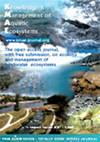安略湖支流七鳃鳗胺处理期间环境DNA分析
IF 1.7
3区 环境科学与生态学
Q3 FISHERIES
引用次数: 1
摘要
海七鳃鳗(Petromyzon marinus)是北美五大湖地区的一种入侵寄生鱼。对湖泊支流中七鳃鳗幼鱼种群的准确估计对于制定有关用3-三氟甲基-4-硝基酚(TFM)处理湖泊支流的控制决策是必要的,TFM是一种对七鳃鳗幼鱼有毒的杀鱼剂。从水样中分离环境DNA (eDNA)分析是近年来海洋七鳃鳗生物监测的一项创新。在安大略湖的一条支流(Ninemile Creek)进行TFM治疗前和治疗后的三个时间点进行eDNA分析,以评估入侵性海七鳃鳗的存在。在TFM治疗前的4个样本位置检测到七鳃鳗DNA,在治疗后72小时的4个样本位置检测到三鳃鳗DNA。在TFM处理后4个月和12个月,在任何地点均未检测到七鳃鳗DNA。这些结果与TFM处理的已知有效性一致,并为eDNA分析作为监测TFM处理导致的海七鳃鳗幼虫丰度下降的工具提供了证据。本文章由计算机程序翻译,如有差异,请以英文原文为准。
Analysis of sea lamprey environmental DNA during lampricide treatment in a tributary of Lake Ontario
Sea lamprey (Petromyzon marinus) is a species of invasive parasitic fish in the Great Lakes region of North America. Accurate estimates of larval lamprey populations in lake tributaries are necessary for making control decisions regarding treatment of lake tributaries with 3-trifluoromethyl-4-nitrophenol (TFM), a piscicide toxic to lamprey larvae. Analysis of environmental DNA (eDNA) isolated from water samples is a recent innovation under consideration for sea lamprey biomonitoring. eDNA analysis was performed before and at three time points after TFM treatment in a tributary of Lake Ontario (Ninemile Creek) to assess presence of invasive sea lamprey. Lamprey DNA was detected in four out of four sample locations before TFM treatment and three of four locations 72 hours following treatment. No lamprey DNA was detected in any of the locations 4 months or 12 months after TFM treatment of the creek. These results are consistent with known effectiveness of TFM treatment and provide evidence for the potential of eDNA analysis as a tool for monitoring decline of larval sea lamprey abundance due to TFM treatments.
求助全文
通过发布文献求助,成功后即可免费获取论文全文。
去求助
来源期刊

Knowledge and Management of Aquatic Ecosystems
环境科学-海洋与淡水生物学
CiteScore
3.70
自引率
5.60%
发文量
22
审稿时长
>12 weeks
期刊介绍:
Knowledge and Management of Aquatic Ecosystems (KMAE-Bulletin Français de la Pêche et de la Pisciculture since 1928) serves as a foundation for scientific advice across the broad spectrum of management and conservation issues related to freshwater ecosystems.
The journal publishes articles, short communications, reviews, comments and replies that contribute to a scientific understanding of freshwater ecosystems and the impact of human activities upon these systems. Its scope includes economic, social, and public administration studies, in so far as they are directly concerned with the management of freshwater ecosystems (e.g. European Water Framework Directive, USA Clean Water Act, Canadian Water Quality Guidelines, …) and prove of general interest to freshwater specialists. Papers on insular freshwater ecosystems and on transitional waters are welcome. KMAE is not a preferred journal for taxonomical, physiological, biological, toxicological studies, unless a clear link to ecological aspects can be established. Articles with a very descriptive content can be accepted if they are part of a broader ecological context.
 求助内容:
求助内容: 应助结果提醒方式:
应助结果提醒方式:


